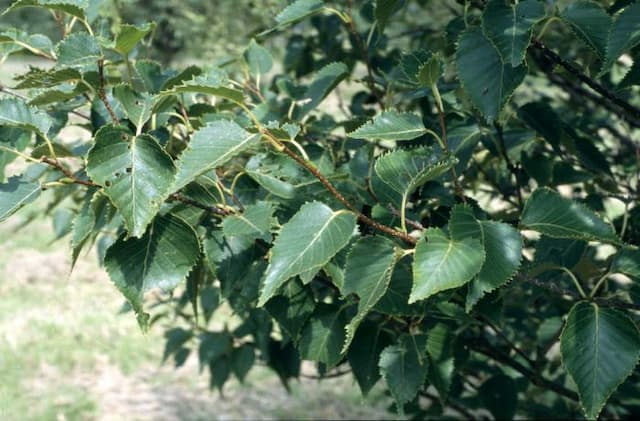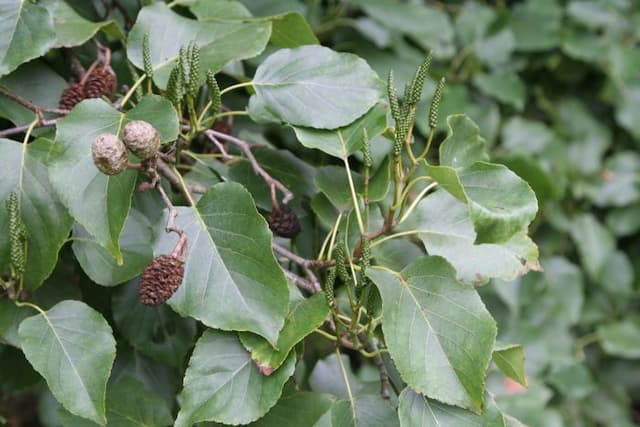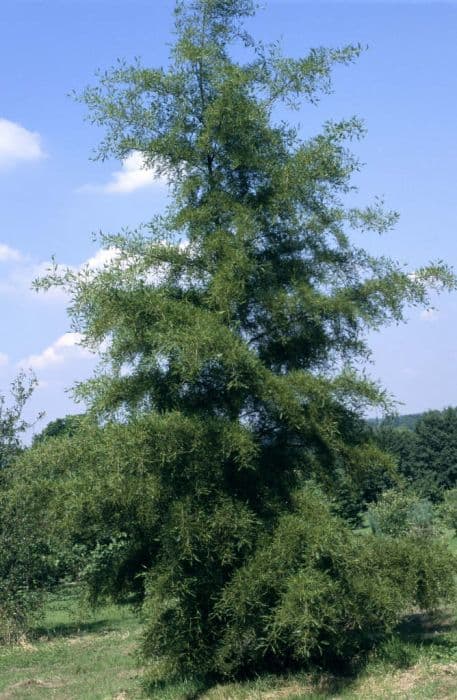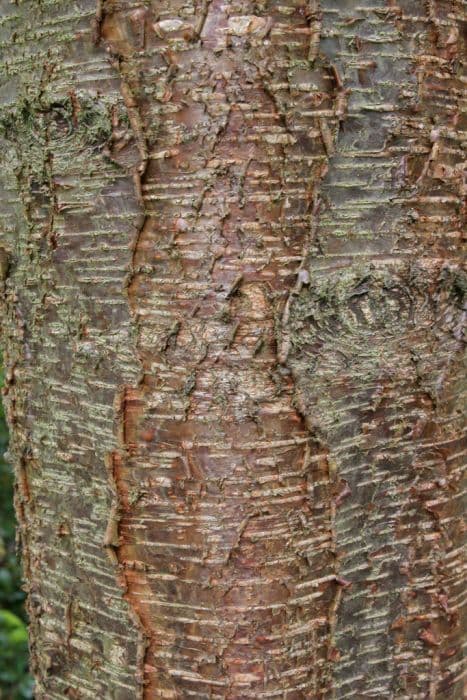Cut-leaf Birch Betula pendula subsp. pendula 'Laciniata'

ABOUT
The plant known as the Cut-leaf Birch, Betula pendula 'Laciniata', is notable for its graceful, weeping posture, with branches that droop delicately towards the ground. This deciduous tree features a striking white bark that peels and cracks with age, providing a stark contrast against the landscape throughout all seasons. The leaves of the Cut-leaf Birch are its most distinguishing characteristic. They are intricately cut, almost fern-like, giving a lacy appearance that is both elegant and intricate. The foliage is a bright green color that turns to a vibrant yellow in the fall, creating a dramatic seasonal display. In spring, this birch produces catkins, which are long, pendulous clusters of flowers. The male catkins are more prominent and hang down from the branches, while the female catkins are smaller and more upright. These turn into small clusters of winged seeds that can catch the wind and disperse throughout the surrounding area. Overall, the Cut-leaf Birch has a delicate and ornamental appearance that makes it a popular choice for gardens and parks, where its textured foliage and exfoliating bark can be admired up close. Despite the exclusion of its size, one can still imagine it being a captivating presence in any landscape.
About this plant
 Names
NamesSynonyms
Cut-Leaf Weeping Birch, European White Birch, Silver Birch.
Common names
Betula pendula var. carelica, Betula pendula var. laciniata, Betula verrucosa var. laciniata.
 Toxicity
ToxicityTo humans
The European white birch is not known to be toxic to humans. Ingesting parts of this plant is not typically associated with poisoning or adverse health effects. However, it's always advisable to avoid eating parts of ornamental plants due to potential pesticide exposure and the lack of information on their edibility.
To pets
The European white birch is not considered toxic to pets. There are no well-documented cases of poisoning in pets such as dogs and cats from consuming any part of this plant. As with humans, it's sensible to prevent pets from eating ornamental plants to avoid potential issues with pesticides or stomach upset from eating non-food items.
 Characteristics
CharacteristicsLife cycle
Perennials
Foliage type
Deciduous
Color of leaves
Green
Height
40 feet (12 meters)
Spread
20 feet (6 meters)
Plant type
Tree
Hardiness zones
3
Native area
Europe
Benefits
 General Benefits
General Benefits- Landscape aesthetics: The Silver Birch 'Laciniata' is a ornamental tree that adds visual interest to landscapes with its unique cut-leaf foliage and graceful, weeping habit.
- Wildlife habitat: It provides a habitat and food source for various wildlife species, such as birds and insects.
- Seasonal Interest: This subspecies of Silver Birch offers seasonal changes in color, with green leaves in spring and summer that turn yellow in the fall.
- Shade provision: It can provide shade in garden and park settings, making outdoor spaces more comfortable during sunny days.
- Erosion Control: The tree helps stabilize soil with its root system, which is beneficial for erosion control on slopes and banks.
- Fast Growth: Silver Birch trees are known for their relatively fast growth rate, which allows for quicker establishment in new plantings.
- Drought Tolerance: Once established, it has a degree of tolerance to drought conditions, which can be beneficial in drier climates or during periods of low rainfall.
 Medical Properties
Medical Properties- Anti-inflammatory: Silver birch has been traditionally used to reduce inflammation.
- Diuretic: It is known to promote the production of urine, aiding in the removal of waste from the body.
- Antiseptic: The sap, leaves, and bark of the silver birch have antiseptic properties.
- Analgesic: There are historical references to its use in alleviating pain.
- Digestive aid: Birch leaves have been used to aid digestion.
 Air-purifying Qualities
Air-purifying QualitiesThis plant is not specifically known for air purifying qualities.
 Other Uses
Other Uses- The cut branches of the Silver Birch are often used as support stakes for other plants in gardens and nurseries.
- Its peeling bark can be used in arts and crafts for decoration or as a natural material in the creation of rustic furniture.
- Due to its distinctive leaf shape, 'Laciniata' can be used in landscape design to create textural contrast.
- The tree's pale bark can be used in photography as a natural backdrop for portrait and macro photography.
- Woodworkers may use Silver Birch wood for making small wooden objects like boxes, due to its fine grain and workability.
- The sap can be fermented to make birch sap wine, a traditional alcoholic beverage in some cultures.
- Dried leaves can be used to create a natural dye for textiles, yielding soft yellow to green shades.
- The Silver Birch's wood can be used as kindling for fires as it ignites easily, even when wet.
- Its twigs and branches can be woven into rustic fences or garden features.
- Branches from Silver Birch can be used in flower arrangements to add a unique, woodland aesthetic.
Interesting Facts
 Feng Shui
Feng ShuiThe European White Birch is not used in Feng Shui practice.
 Zodiac Sign Compitability
Zodiac Sign CompitabilityThe European White Birch is not used in astrology practice.
 Plant Symbolism
Plant Symbolism- Growth and Renewal: The Silver Birch is often associated with new beginnings and regeneration because it is one of the first trees to grow back after a forest is cleared or after a fire.
- Adaptability and Resilience: Known for its ability to thrive in various conditions, the Silver Birch symbolizes the ability to adapt and survive adversity.
- Purity and Cleansing: With its bright white bark and association with birch water, which is believed to have detoxifying properties, the Silver Birch represents purification.
- Protection: In several cultures, birch trees were thought to ward off evil, so they symbolize safeguarding and protection.
- Beauty and Grace: The Silver Birch, particularly the 'Laciniata' cultivar with its delicate, finely cut leaves, is aesthetically graceful, representing beauty and elegance in the plant world.
 Water
WaterThe Cutleaf Weeping Birch should be watered deeply, allowing water to penetrate several inches into the soil, which encourages deep root growth. It's best to water this tree about once or twice a week during its growing season, especially if the weather is dry. During the winter months, reduce watering to when the soil appears dry as the tree is dormant. Each watering session should provide enough water to soak the ground around the root zone; for young trees, this can mean 10 to 15 gallons per week, while mature trees may require 15 to 30 gallons every couple of weeks depending on soil conditions and climate.
 Light
LightThe Cutleaf Weeping Birch thrives in full sun conditions. It requires at least six hours of direct, unfiltered sunlight each day. The best spot for this tree is in an open landscape away from buildings or other large plants that could cast shade, enabling it to receive ample sunlight from above.
 Temperature
TemperatureThe Cutleaf Weeping Birch is hardy and can tolerate temperatures as low as -40 degrees Fahrenheit and as high as 85 degrees Fahrenheit. However, the ideal temperature range for this plant is from 50 to 75 degrees Fahrenheit. It can adjust to a variety of temperature conditions but extreme heat or cold could stress the tree.
 Pruning
PruningPrune the Cutleaf Weeping Birch to remove dead or diseased branches, improve structure, and encourage healthy growth. Pruning should be done in late fall or winter while the tree is dormant. Annual pruning is sufficient to maintain its shape and health. The best time for pruning is after the leaves have fallen and before spring growth starts.
 Cleaning
CleaningAs needed
 Soil
SoilThe Cut-leaf weeping birch thrives in moist, well-draining soil with a pH range of 4.5 to 6.5. A soil mix with equal parts loam, peat, and sand is ideal to ensure good drainage and a healthy root environment.
 Repotting
RepottingCut-leaf weeping birch trees, being large landscape specimens, are not typically repotted. Instead, they are planted in a suitable location where they can grow undisturbed for many years.
 Humidity & Misting
Humidity & MistingCut-leaf weeping birch prefers outdoor conditions with average ambient humidity. It does not require specific humidity levels when grown in its natural environment.
 Suitable locations
Suitable locationsIndoor
Not suitable for indoor cultivation due to size.
Outdoor
Plant in well-draining soil, full sun, water regularly.
Hardiness zone
2-7 USDA
 Life cycle
Life cycleBetula pendula 'Laciniata', commonly known as the Cutleaf Birch or European White Birch, begins its life as a seed that germinates after dispersal, often requiring stratification through a cold winter to break dormancy. As a seedling, it quickly establishes a root system and shoots up towards the light, entering the sapling stage characterized by rapid vertical growth and the development of the signature deeply cut, lace-like leaves. The tree reaches maturity over several years and starts to reproduce, forming catkins that release pollen to fertilize other birch flowers, leading to seed production. As it matures, the Cutleaf Birch develops a slender trunk with distinctive white, peeling bark and a graceful, often weeping habit. Throughout its adult life, typically lasting 40 to 80 years, it will experience cycles of growth, reproduction, and dormancy, typically marked by annual leaf flush in spring and leaf abscission in autumn. The tree eventually enters a senescence phase, where growth slows, and it becomes more susceptible to environmental stress and diseases before finally dying.
 Propogation
PropogationPropogation time
Spring-Early Summer
Propogation: The common name for Betula pendula subsp. pendula 'Laciniata' is Cutleaf or Lacinate Birch, and the most popular method of propagation for this variety is by softwood cuttings. This is typically done in late spring to early summer when the new growth is still soft and flexible. Cuttings should be taken from healthy branches, ideally 4 to 6 inches (10 to 15 centimeters) in length, with several leaves. The lower leaves are removed, and the cut end is dipped in rooting hormone to encourage root development. Plant the cutting in a well-draining soil mix, ensuring high humidity and consistent moisture until roots are established, which usually takes a few weeks. After rooting, the cuttings can be transplanted to their final location.









